Advance requirements
- Description
- Registration in the dispo account
- Explanatory notes on bookings in the dispatcher account
- Cancellation of advance requirement items
- Overhangs
- Related topics
Description
Advance requirements are used to cover real requirements that are generated at a later date. This is useful for parts with long replenishment lead times (planned delivery time or in-house production time). For this reason, preliminary requirements make no sense for e.g. level 0 parts within a sales order. You can create the corresponding order item directly and do not have to take the diversion via advance requirements.
Therefore, preliminary requirements should only be created for MRP sub-items of a production BOM that has not yet been exploded and technically released as a whole, if the time between technical release and the required procurement date is shorter than the expected delivery time. However, the same can also apply to sub-items kept in stock, which have a very low minimum stock level, show high consumption and also have a relatively long delivery time. There you can use the advance requirements to reserve a certain number of parts in the warehouse before the actual disposition of the finally exploded parts list.
The system only makes sense if the planned part is actually scheduled at a later point in time, i.e. can be offset. It therefore makes no sense to create an advance requirement for part X, whereby this part always occurs as a component of the higher-level and stock-keeping part Z, and this part Z is also ultimately planned. It makes just as little sense to create an advance requirement for a part that only appears in parts lists as a constructive (fictitious) item and is ultimately never manufactured and is therefore not planned.
Advance requirements documents can be created in the course of planning. When creating a preliminary requirement, it is specified for which order and on which date how much goods are expected to be needed. A preliminary requirements document can contain several items. Only one - not completed, openly running - preliminary requirement can be triggered per order for each part.
A scheduled advance requirement item (with a staging date) is posted in the MRP account as a requirement trigger ("future issue") and therefore leads to an increase in requirements for the corresponding part.
The "aim" of the document is to reserve or procure the preplanned quantity in advance. Later, the respective advance requirement item is replaced by a "real" requirement trigger in the MRP account; this can be an order item or a part requirement item.
Registration in the dispo account
Advance requirements always post two quantities in the MRP account:
1. sales order quantity (quantity of the advance requirement item not yet staged)
2. reserved quantity (quantity of the advance requirement item not yet allocated to an order item)
More about the bookings here.
The advance requirement remains in the MRP account until it has neither an open, unallocated quantity nor an open, uncommitted quantity left.
For example, an advance requirement may appear in the MRP account with open quantity 0. This then only counts up the reserved quantity.
How the demand is met depends on whether the part is a purchased part or a production part.
Purchase part:
When saving a scheduled (i.e. a provision date has been entered) advance requirement item with an MRP purchased part, a requirement request is automatically generated which then participates in a normal procurement cycle(approval, order, etc.). The requirement generated by the advance requirement is thus immediately covered again by a requirement request or purchase order in the MRP account.
When the goods receipt arrives, it can be immediately prepared for this order. Even if the advance requirement has not yet been assigned to an order item.
The demand for stocked purchased parts is normally reported via the demand and stock list, which can also be used to start the supply chain.
Production part:
As soon as scheduling is complete (i.e. a provision date has been entered), the production cycle can be started for the advance requirement item with a production part: by pressing the button "Explode parts lists" (in the toolbar on the advance requirement item screen) the explosion of the parts list defined for the part is started.
The requirement is covered by the corresponding production order item.
The quantity reserved by an advance requirement item can be used up in two cases:
1. a part is pre-planned for an order -> in the order an order item with the same part is created => the order item is automatically linked to the advance requirement item (document history ) and the quantity is transferred
If the full reserved quantity has been consumed (order item quantity greater than or equal to the quantity reserved via advance requirements), the advance requirement is thus automatically completed; otherwise, only the order item quantity is rebooked.
2. a part is preplanned for an order -> for an order item in the order a part request for production is created (e.g. a gozintograph), in which the preplanned part is needed => the corresponding part request item is automatically linked to the advance requirement item (document history), disposition type is set to "advance" type and the quantity is transferred.
If the full reserved quantity has been consumed (part requirement item quantity greater than or equal to the quantity reserved via advance requirements), the advance requirement is thus automatically completed; otherwise, only the part requirement item quantity is transferred.
Cancellation of advance requirement items
The "Remove" button above the list in the pre-requirement editing window can be used to remove pre-requirement items.
If this advance requirement has not yet been further processed, it can simply be deleted. However, if a requirement request has already been made or a bill of material exploded, or if this preliminary requirement has already been linked to a requirement trigger, the system must take various special features into account when deleting. All possibilities are displayed here in the list and explained what happens to their successors:
| Editing state | Connecting state |
|---|---|
Advance supplies have not yet been further processed  | Completely deleted |
The production parts list has already been exploded for advance requirements  | Completely deleted |
A requisition has already been created for advance requirements  | advance requirement item = cancelled requirement request = cancelled  |
Advance requirements have not yet been further processed but have already been linked to an order item  | Advance requirement item = deleted Order item = separate  |
A requirement request and a purchase order have already been created for advance requirements, advance requirements were linked to level 0 AU item  | advance requirement item = cancelled Requirement request item = stopped (is automatically cancelled if order is cancelled by buyer)   |
A requirement request, a purchase order and a goods receipt have already been posted for advance requirements, advance requirements have been linked to level 0 AU item 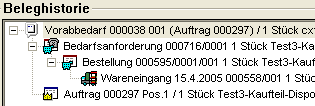 | advance requirement item = cancelled Requirement request item = cancelled Order item = stopped because a goods receipt quantity has already been posted. As soon as the goods receipt quantity has been eliminated via a return document or putaway, the delivery schedule line can be cancelled manually.   |
A production parts list has already been exploded for advance requirements, parts request+production order created  | advance requirement item = cancelled Part request item = cancelled Production order item = cancelled  |
For advance requirements a production bill of materials has already been exploded, parts request+production order created and linked to AU level 0 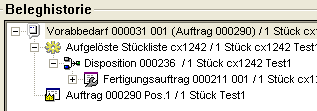 | advance requirement item = cancelled Part request item = cancelled Production order item = cancelled Order item = separate   |
For advance requirements a production bill of materials has already been exploded, parts request+production order created and linked to parts request item of AU level > 0 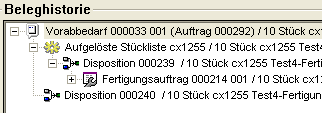 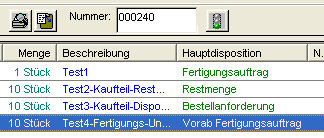 | advance requirement item = cancelled Part request item = cancelled Production order item = cancelled Connected parts request position = separated and changed to standard disposition. The scheduling and release of the part requirement item was cancelled. The release of the part request itself must be cancelled manually before the cancellation of the advance requirement item (otherwise a note will appear!)  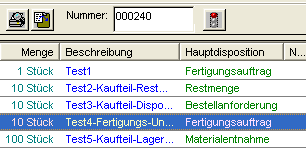 |
Bookings of preliminary requirements
| Registered quantity in the dispo account | |||||
| Situation | Advance requirements reserved quantity reserved.quantity (Quantity not yet allocated to the advance requirement item) | Advance requirements Customer demand quantity ored.quantity (Quantity not yet mobilised of the provisional requirement item) | Part requirement_1 (departure) ordered.quantity (parts requirement item resulting from further processing of the advance requirement) | Construction contract (access) produced.quantity | Part requirement_2 (connected) (departure) ordered.quantity |
|---|---|---|---|---|---|
Only advance requirements created  | 1 piece | 1 piece | |||
| Advance requirement not yet processed but already associated with part requirement item. parts requested quantity = advance requirement quantity  | 10 pieces | ||||
| Advance requirement not yet processed but already associated with part requirement item. Parts requested quantity > Advance requirement quantity  | 10 pieces | 5 pieces | |||
Advance requirements already processed in Gozinto, not yet connected  | 10 pieces | 10 pieces | 10 pieces | ||
Advance requirements processed in Gozinto and linked to further Gozinto position 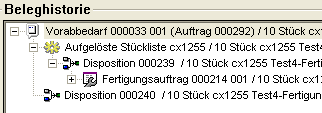 | 10 pieces | 10 pieces | |||
| Pre-orders processed in Gozinto and linked to further Gozinto positions: Not full requested quantity: Parts requested quantity > Advance requirement quantity 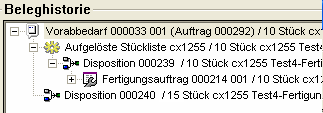 | 10 pieces | 10 pieces | 5 pieces | ||
The Gozint item that was created directly from the advance requirement (not linked) is never posted to the MRP account. (Maximum.level=0 or has predecessor requirement and at the same time no captured.quantity) The linked Gozintoposition is only posted with the amount.Amount() - captured.quantity
| Advance requirements | Dispatch account | |||
|---|---|---|---|---|
| estimated.quantity | transferred.quantity | ordered.quantity | ordered.quantity | reserved.quantity |
| 10 | 0 | 0 | 10 | 10 |
| 10 | 5 | 0 | 5 | 10 |
| 10 | 0 | 5 | 10 | 5 |
| 10 | 5 | 5 | 5 | 5 |
| 10 | 5 | 2 | 5 | 8 |
| 10 | 2 | 5 | 8 | 5 |
| Advance requirements: | |
| ordered.quantity | Quantity associated with sales order item or gozint item |
| transferred.quantity | quantity planned and made available for advance requirements |
| Discount account: | |
| ordered.quantity | Sales order quantity: The advance requirement quantity that has not yet been made available |
| reserved.quantity | Reserved quantity: Advance requirement quantity that is not yet linked to sales order quantity |
| Calculation of the dispo account fields: | ||
| ordered.quantity(dispo account) = estimated - transferred | = still open to disposition (to be provided) for VB | |
| reserved.quantity(dispo account) = estimated - ordered | = not yet connected |
Overhangs
If there is a warehouse stock for an MRP part of the preliminary requirement item, a partial warehouse reservation is created via a warehouse reservation document if the option "Consume surplus quantities automatically" is set. If the complete advance requirement quantity is available, the complete quantity is also reserved by the warehouse. In case of partial quantities, the reserved quantity is reduced by the following document (part request or requirement request).